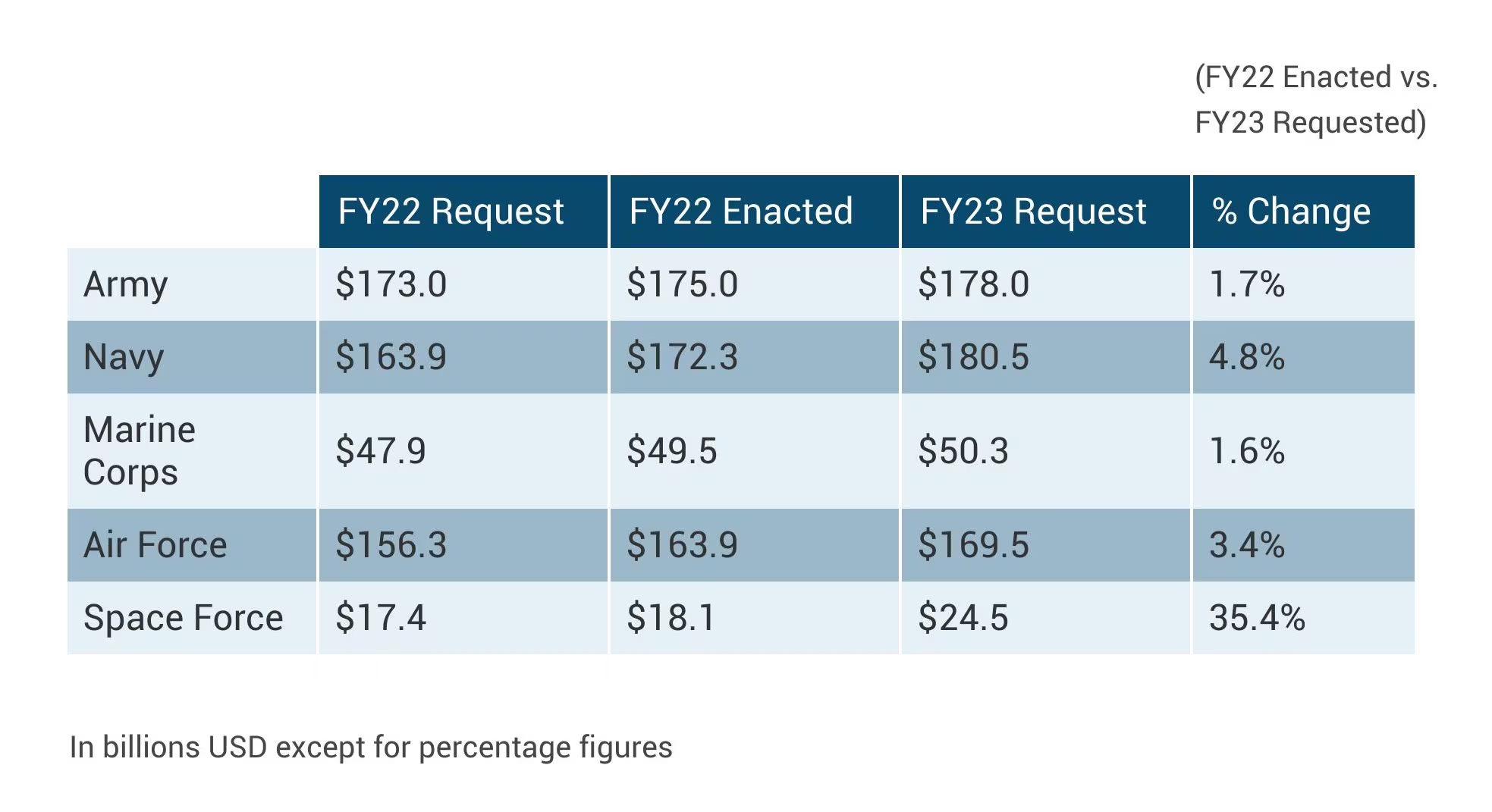WASHINGTON ― Defense Department spending would see a 4% increase in fiscal 2023 under a plan released by the White House on Monday, significantly above what administration officials wanted last year but likely not enough to satisfy congressional Republicans.
Administration officials said the $773 billion plan includes new money to help Ukraine in its fight against Russia, new investments in military aircraft and nuclear deterrence systems, and enough funding to counter “persistent threats including those posed by North Korea, Iran and violent extremist organizations.”
The total spending plan translates to an increase of more than $30 billion, or 4%, over the fiscal 2022 enacted level.
Last year, White House officials sought a boost of less than 3%, prompting a yearlong fight with Republicans and moderate Democrats who eventually added more to the Pentagon’s spending totals.

Even with the larger request this year, that debate is likely to repeat. Last week, 40 House and Senate Republicans pushed the White House to increase the national defense budget by at least 5%, in response to mounting inflation and growing worldwide threats. Sen. Roger Wicker, R-Miss., on Monday called the request “strategically unsound” and argued Congress must alter it to deter Russia, China and other threats.
“To meet this challenge, our top military brass from all branches are wisely asking for more. More ships, more planes, more weapons, more satellites, and more training,” said Wicker, the No. 2 Republican on the Senate Armed Services Committee. “But President [Joe] Biden is instead providing them less to complete their mission. This is strategically unsound and could increase the risk of future conflicts and threats to our country.”
In a statement Monday, Biden called the proposed budget plan “one of the largest investments in our national security in history, with the funds needed to ensure that our military remains the best-prepared, best-trained, best-equipped military in the world.”
White House officials noted that if approved, the budget plan would amount to a 9.8% increase in defense spending in the last two years, providing “the resources necessary to sustain and strengthen U.S. deterrence [and] advancing our vital national interests.”
For another year, the budget emphasizes research, development, test and evaluation funding, with $130.1 billion, a 9.5% increase, as the “largest ever.” Included are $4.7 billion for hypersonic weapons, $3.3 billion for microelectronics and 5G networking and $1.3 billion for biotechnology.
Though Congress upended plans last year to divest from “legacy platforms,” the administration has proposed similar plans again, noting it reprioritized $2.7 billion in spending. The Air Force would retire 150 aircraft and transfer 100 MQ-9s to another government agency, while the Navy would decommission 24 ships ― 16 before the end of their service lives.
“The department had some success last year making progress in some of these areas, and the reason the department keeps asking is it’s something that needs to happen,” a senior defense official told reporters last week.
The budget requests $6.2 billion for the European Deterrence Initiative, with $300 million for Ukraine, as it fights off a Russian invasion. The Pentagon, with China still its “pacing challenge,” seeks $6.1 billion for the Indo-Pacific Deterrence Initiative.
It also includes full funding for modernizing all three legs of the nuclear triad, with $34.4 billion for the nuclear enterprise. That includes $6.3 billion for the Columbia-class submarine, $5 billion for the B-21 bomber, and $3.6 billion for the next-generation intercontinental ballistic missile known as the Ground Based Strategic Deterrent ― with $4.8 billion for nuclear command-and-control systems.
The Pentagon noted proposed investments in supply chain resiliency, including $3.3 billion for microelectronics, $605 million to expand suppliers of hypersonic and directed energy weapons, $253 million for “critical materials,” $48 billion for casting and forging, and $43 million for batteries and energy storage.
The White House touted the defense industrial base as a source of innovation, according to a budget summary.
“DOD plays a critical role in overall federal research and development that spurs innovation, yields high-value technology, ensures American dominance over strategic competitors, and creates good-paying jobs,” the White House summary said.
“The budget prioritizes defense research, development, test, and evaluation funding to invest in breakthrough technologies that drive innovation, support capacity in the defense technology industrial base, ensure American technological leadership, and underpin the development of next-generation defense capabilities,” it continued.
Defense officials have acknowledged the budget reflects lost buying power. The Pentagon finished its budget in mid-January, before the Ukraine crisis and a resulting rise in fuel prices.
“Inflation going forward, based on Russia’s impact in Ukraine on spiking fuel prices, that’s a new variable that will have to be addressed, but that happened after we were already done,” the senior defense official said.
Biden asked for $753 billion in overall defense and national security spending for FY22, but Congress ultimately increased that to $782 billion.
An analysis by Capital Alpha Partners’ Byron Callan noted the Republican target is likely $875 billion for overall defense and national security spending.
“We don’t dismiss the odds of an increase of this magnitude occurring but the final outcome may not be determined until 2023 for appropriations,” Callan said in a note to investors Sunday.
Megan Eckstein and Stephen Losey contributed to this report.
Joe Gould was the senior Pentagon reporter for Defense News, covering the intersection of national security policy, politics and the defense industry. He had previously served as Congress reporter.
Leo covers Congress, Veterans Affairs and the White House for Military Times. He has covered Washington, D.C. since 2004, focusing on military personnel and veterans policies. His work has earned numerous honors, including a 2009 Polk award, a 2010 National Headliner Award, the IAVA Leadership in Journalism award and the VFW News Media award.








